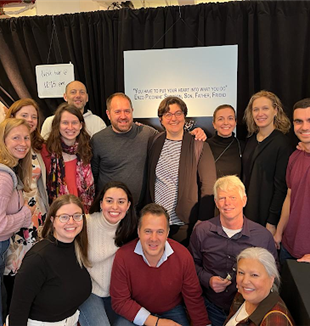
Enzo Piccinini: Surgeon, Son, Father, Friend
A month after the New York Encounter, curators of the exhibit on Enzo Piccinini share their experience of this work they did together.“We did so little to make this happen, but there’s been so much that’s been generated from this.” Luke, one of our teammates and friends who worked on the exhibit for the New York Encounter – Enzo Piccinini: Surgeon, Son, Father, Friend – began his judgment on our work in this way. During a “final” Zoom meeting in which we reflected on what the past six months of work have meant for each of us, Luke’s statement was echoed by all of us. In short, over these last months it has been abundantly clear that “someone else” was working on the project.
Instead of curating a chronology of one man’s life, we, through our work, demonstrated something happening now, today, among us. We could have told the story about Enzo; instead we told the story of how doing this work changed our life, which is much more meaningful.
In fact, several personal friends of Enzo’s – including two of his daughters – traveled from Italy to see the exhibit and meet the curators. They did not come to learn new facts about Enzo’s life (indeed, they know much more than what was depicted in the exhibit!), but to see how his witness has changed the lives of those of us who never knew him.
“We paid attention to what was happening,” said Caroline. “We all had our own ideas coming into this work, and they all changed according to what we saw in front of us – and thank God they did! The fact that the exhibit was always packed full of people was not a testament to our grit or ability to synthesize information, but that we responded to what was in front of us. And this is how I want to live – by starting from what is in front of me as opposed to my own ideas.”
Another surprising outcome from the exhibit was the generation of new friendships, despite our radically different circumstances. Prior to beginning this work, many of us didn’t know each other, or perhaps only peripherally.
“The last thing I wanted to do when this started was to have another Zoom meeting. It wasn’t always out of gratuity that I participated. The thing that is most fascinating about this was what happened among us because of this man [Enzo Piccinini],” said Christine.
“How is it possible that in all of our different circumstances we could each say this was specifically tailored to us? That it was so crucial for each of our lives?” said Nick.
“This exhibit illustrates perfectly that doing work together generates communion. I’m grateful now because I have new friends,” said Joe.
The demands of the behind-the-scenes work to build the exhibit often seemed to conflict with our daily life responsibilities. What we discovered, however, was that in giving ourselves to something greater, we found ourselves happier. This experience is perhaps best summarized in a quote from Enzo Piccinini featured in the exhibit: “It is gratitude that characterizes my life, so I’m not afraid to give it away completely.”
“One of the most important things I’ve been reminded of through this, is that I find myself most glad when I’m giving myself away for something concrete that’s asked of me, rather than when I preserve my free time for an ideal of what I want to do,” said Jess.
“I regret I wasn’t always as invested in the work as I wanted to be, but my gratitude goes to the fact that it's always possible to start over. I started over the day before I got to the New York Encounter. Ultimately, it was truly something I needed. That is, the witness of this man borne out in the witness of all of us. I realized that the only approach to the inertia which I’ve suffered for many months is to go deeper in whatever is in front of me – work, boredom, etc. I really wanted to pay greater attention to my work and take the risk of trying harder or accepting more responsibility,” said Joe.
As one of the few on the team who knew Enzo Piccinini when he was alive, Alberto was particularly struck by the fact that most of the people dedicated to the exhibit poured themselves into it, even without ever having met Enzo in person. “To me, the fact that people are changed working on this 20 years after he died is even more real than hiking with him. That’s why it was beautiful for others to come see the exhibit, because you see that life changes in front of someone exceptional,” he said.
It would be easy to look at the exhibit as a task that is now complete, and let the excitement and memories fade in time. Instead, each of us walked away with a keen awareness that this is the start of something new.
“I want this exhibit to last forever,” said Nick. “I can say with certainty that I don’t want to be alone, and that I desire what happened to me and to us to last forever. I see that I’m not alone because I belong to something bigger than myself, and this exhibit exemplified that. And because it is bigger than myself, it has the capacity to last forever. Not because I will it by my own hands but because of the mystery of this companionship. Life has a radical newness now – one with a face.”